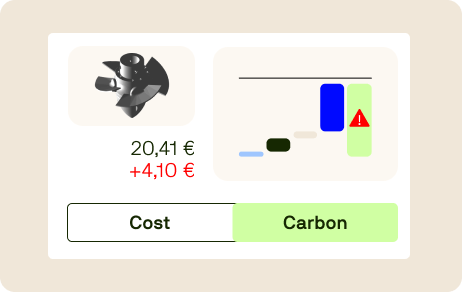The innovative solution empowers the customer to enhance cost efficiency and competitiveness.
Webinar: 24th of July @11AM – How Modern Cost Engineering Delivers 5–10x ROI
We deliver: Knowledge. Data. Software.
Introducing the next-gen solution for sustainable manufacturing and cost reduction. Our software combines data-driven algorithms and hands-on industry knowledge.
Our impact
We are dedicated to transform cost & carbon management across the manufacturing industry, addressing the full spectrum of the product life cycle for enhanced sustainability and efficiency.
Up to 15% of efficiency gain throughout your entire supply chain by using Tset software.
Eliminate your bottlenecks in cost engineering. Ten times faster cost calculation with Tset.
How It Works
We are committed to streamlining the laborious and time-sensitive process of product cost and carbon calculation through automation.
How does Tset work?
Tset offers more than just a software: it gives cost engineers the efficiency and time to empower them for the best results. The fusion of industry-leading expertise and state-of-the-the art technology allows you to work better towards success.

Understand
Early-stage evaluation of entire systems within minutes, immediately improving design-to-cost and target setting.

Analyze
Data-driven calculations within seconds, increasing the efficiency of your cost engineering and sustainability activities.

Optimize
Powerful analytics toolkit for developing cost-saving measures helps you focus on the most effective measures and prioritize accordingly.
One software. Different use cases.
How our customers use Tset.
Read our customer case studies to understand how world-leading players of the manufacturing industry already rely on Tset.
By using the innovative Tset solution, the automotive supplier shortens innovation processes and increases transparency regarding CO₂ emissions.
The most important development steps and lessons learned in the implementation of cost engineering at Pierer Mobility AG.
Nice to Meet You
Discover our software solutions to see for yourself. We're happy to design an individualized package for your business upon request.
All in one solution
Discover our comprehensive product features and see for yourself why customers trust Tset as their ultimate solution.
Calculate & Simulate
Tset offers a comprehensive cost & carbon simulation experience, powered by advanced algorithms enabling rapid bottom-up calculations. Developed by manufacturing experts for manufacturing experts.
Manage & Integrate Your Data
Tset comes with a comprehensive set of industry benchmark data (library of 1.000+ templates) as well as standardized APIs for the integration of your data — plus advanced data management capabilities.
Optimize Automatically
No Black-Box. All calculations and results are user-editable in detail and fully configurable to your individual needs.
Join Our Team
Join Tset. We challenge established and complex patterns to break new grounds and innovate. Work with experts for experts.





























